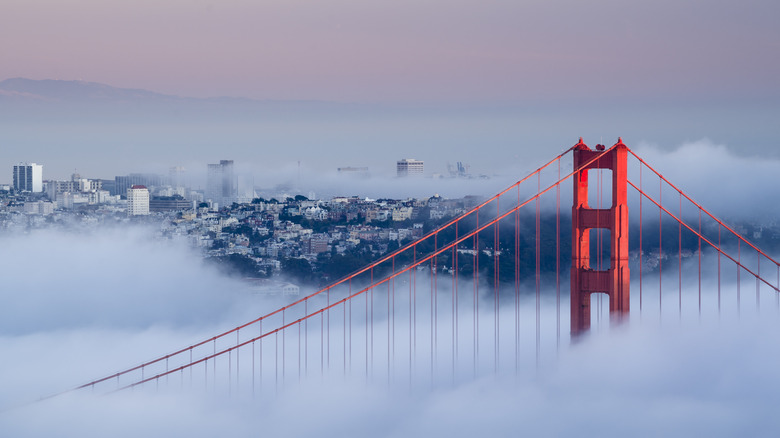What Every Tourist Needs To Know About San Francisco's Notoriously Fickle 'Microclimates'
San Francisco is one of the best U.S. destinations for international tourists, and there is something special about the City by the Bay that inspires visitors to wax lyrical about its beauty, culture, and atmosphere. Frisco's unusual weather often plays a large part. Mark Twain reputedly quipped that the coldest winter he'd experienced was the summer he spent in the Californian metropolis, and many other artists, writers, and celebrities have tried to find the words to evoke the unique vibe that its notoriously fickle microclimates create. English model and actress Twiggy once described the city as "London and Paris stacked on top of one another" and, much like Londoners, San Fran natives sure like to talk about the unpredictable weather that often catches out tourists.
For example, locals speak fondly of Karl, the nickname given to San Francisco's famous fog bank that rolls in beneath the Golden Gate Bridge. Locals and past visitors know that temperatures can vary substantially from neighborhood to neighborhood. There is a lot going on weather-wise in such a relatively small area, and those in the know dress for sudden fluctuations while moving around town. San Francisco's location and topography are what make its microclimates a thing: Situated on a peninsula with the Pacific Ocean to the west and San Francisco Bay to the north and east, both the incredibly steep streets and the city's proximity to water are two major factors. Let's take a closer look at why and how visitors can prepare themselves for unexpected conditions.
What causes San Francisco's microclimates?
San Francisco has water on three sides, which keeps temperatures down. Because of this, it is the coolest city in the continental United States on average during the summer months. The combination of these factors contributes to the city's foggy season, which runs from April through October each year. Warm breezes blowing in off the Atlantic pass over the surface of cold water along the coast, forming advection fog. This type of fog is dense and rolls in horizontally through the Golden Gate Bridge (a must-visit for your California travel bucket list) as it is drawn towards warmer air inland. This makes the Bay Area notoriously foggy during the summer months, and nearby Point Reyes registers an average of 200 foggy days per year.
Fog is defined as "visible moisture" that usually lingers beneath 50 feet, which means it tends to inundate lower-lying districts of San Francisco more and affects the city's microclimates. Within just a few miles, neighborhoods can fluctuate wildly in temperature depending on their altitude and how close they are to the shoreline. An extreme example occurred in October 2024 when Ocean Beach reached a comfortable 69 degrees Fahrenheit, while downtown residents in the Mission District sweltered in 90-degree heat. It is not uncommon for districts located on higher ground to be less foggy or entirely fog-free, while neighborhoods close to the water's edge are still shrouded. Another factor is that San Francisco's built-up areas may also contribute to its microclimates, with tall buildings creating man-made canyons that can channel winds and alter the natural progress of the fog.
Preparing for microclimates in San Francisco
If you are visiting the Bay Area during the foggy season, get ready for "May Gray" through "No-Sky July" to "Fogust" – the latter is the local nickname for August, the city's peak time for fog. Don't despair, however. Many citizens love their fog, and it adds to the atmosphere if you're ready for it. It is all part of life in San Francisco, and the microclimates even affect house prices. Homes in sunnier districts can cost up to 20% more than properties in areas with less certain conditions.
Generally speaking, parts of town on the western and northern shorelines tend to be cooler, foggier, and windier than districts on the eastern and southern sides of the city. These areas typically enjoy clearer skies and higher temperatures. Golden Gate Park and the Panhandle are something of an anomaly: Forming a corridor into the heart of the city from the beach, temperatures are often recorded as several degrees cooler than the built-up neighborhoods on either side.
San Francisco natives prepare themselves for the quirks of the city's microclimates by dressing in layers so they can strip off when it is warm and quickly wrap up again if it suddenly gets chilly and/or rainy. Visitors are advised to bring a selection of t-shirts, long sleeves, and light jackets so they can mix and match according to whatever the weather is doing or adjust as they move from one district that may be foggy to another basking in sunshine.


